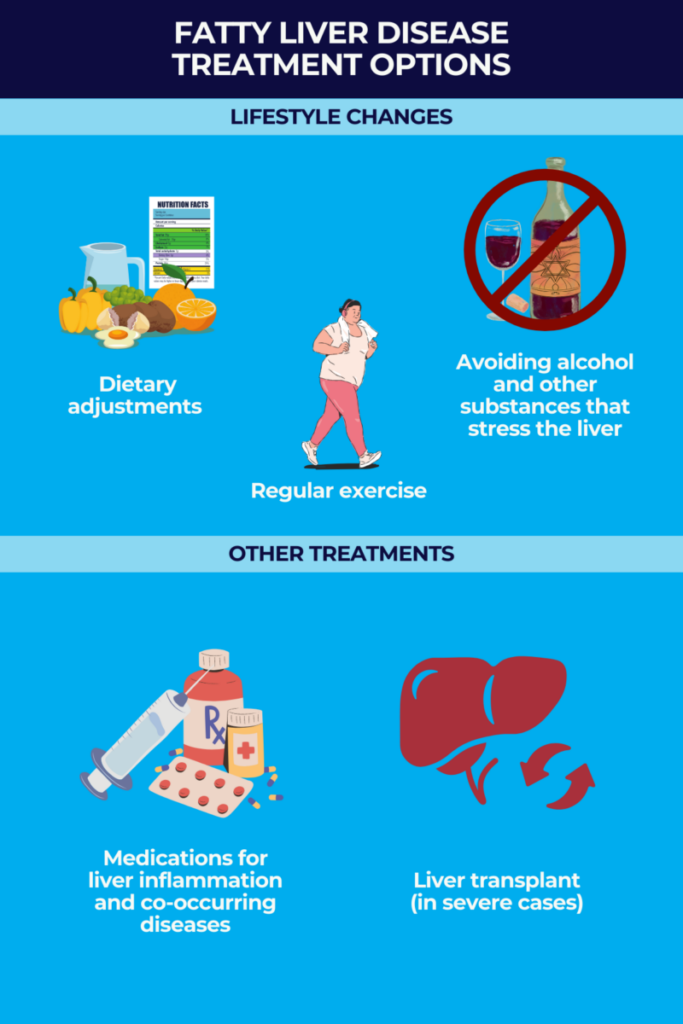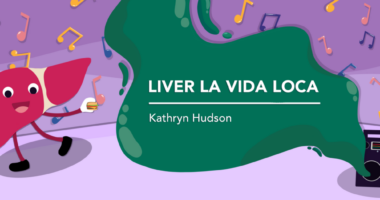Fatty liver disease treatment and management
Last updated Aug. 25, 2025, by Marisa Wexler, MS

Fatty liver disease — now formally known as steatotic liver disease (SLD) — refers to a group of disorders characterized by an abnormal buildup of fat in the liver.
This nomenclature was updated in 2023 to better reflect the underlying causes of each disease type and to create novel types that would formerly fall under NAFLD.
Symptoms of fatty liver aren’t always evident, especially in the early stages, but if left untreated, the condition can progress to cause serious liver damage and life-threatening complications, such as liver failure and liver cancer.
Fatty liver disease treatment approaches will depend on the condition’s exact cause. But patients are generally encouraged to make lifestyle changes, such as diet and exercise, aimed at promoting weight loss and reducing the amount of fat in the body.
Patients also should take proactive steps to maintain liver health, which may include limiting alcohol intake, avoiding exposure to toxins and certain medications, and getting regular health checkups.
Treatment by type
Fatty liver disease has traditionally been divided into two main types: alcoholic fatty liver disease, or AFLD, and nonalcoholic fatty liver disease, known as NAFLD. Having AFLD means the disease develops due to liver damage caused by excessive alcohol consumption, while NAFLD encompasses all other causes.
This nomenclature was updated in 2023 to better reflect the underlying causes of each disease type and to create novel types that would formerly fall under NAFLD.
Nowadays, AFLD is called alcohol-associated liver disease or alcoholic liver disease (ALD), and most people who were previously classified as NAFLD are diagnosed with metabolic dysfunction-associated SLD, or MASLD, which is defined by fatty liver in the presence of one or more cardiovascular risk factors.
The remaining NAFLD patients are now diagnosed with other forms of the disease. These include metabolic dysfunction and alcohol-associated liver disease (MetALD) — which comprises people who meet criteria for MASLD and also drink high amounts of alcohol — and drug-related SLD, which is caused by a medication or drug. Another novel disease type is cryptogenic SLD, where the cause of fatty liver cannot be determined.
Fatty liver treatment approaches are largely determined by the disease type a person has. The cornerstone of AFLD treatment is avoiding alcohol intake, and stopping the disease-driving agent is also the mainstay treatment for drug-related SLD. In most cases, the liver is able to repair itself once the causative drug is discontinued; however, a minority of patients may experience persistent damage requiring more intensive treatment, such as a liver transplant.
For individuals with metabolic alterations, primary NAFLD treatment strategies involve lifestyle modifications focused on lowering body fat, including dietary adjustments and regular exercise, and medications also may be considered in some patients.
MASLD can generally be divided into four stages of fatty liver progression:
- In simple fatty liver, there’s more fat than normal in the liver.
- In steatohepatitis, fat accumulation is accompanied by liver inflammation.
- In liver fibrosis, the underlying inflammation starts to cause tissue scarring.
- Finally, in cirrhosis, pronounced scarring interferes with liver function.
In the initial stage of the disease, fatty liver can be reversed with a few lifestyle changes, specifically ones aiming to promote weight loss. But as patients progress to the second stage — called nonalcoholic steatohepatitis (NASH) or, more recently, metabolic dysfunction-associated steatohepatitis (MASH) — more extensive lifestyle changes will be required to reverse at least some damage. Patients in this stage may also be prescribed one of two medications, Rezdiffra (resmetirom) or Wegovy (semaglutide), which can ease liver inflammation and scarring in people with moderate to advanced liver fibrosis. Medications also may be considered as part of MASH/NASH treatment strategies to help with the underlying conditions or facilitate weight loss.
Acute fatty liver of pregnancy (AFLP) is a rare type of fatty liver disease that can appear suddenly in the last stages of pregnancy. This form of the disease usually resolves on its own after delivery, so management consists of getting the baby born healthy as soon as possible after the fatty liver diagnosis. Supportive measures are put into place to keep the pregnant person healthy while the liver recovers.
Weight loss and other lifestyle changes
For most patients, losing weight is the best treatment for fatty liver disease. By lowering the total amount of fat in the body, fat in the liver will likewise be reduced, which eases fatty liver disease.
Weight loss is especially considered a cornerstone of treatment for MASLD, which is related to cardiovascular risk factors such as obesity and diabetes. Studies have shown that participating in weight loss programs can reduce fat accumulation in the liver and also lower markers of liver inflammation and damage.
It’s generally accepted that losing at least 5% of total body weight can reduce liver fat and lessen cardiometabolic risk in most MASLD patients, but more weight loss is associated with better outcomes. For example, a 10% or greater weight loss is believed to reverse some of the inflammation and fibrosis, or scarring, that has already taken place in later stages of the disease.
Yet, it should be emphasized that losing significant weight too quickly — more than about 1 kg (2.2 lbs) per week — can cause health problems of its own. Thus, it’s important that patients work with their clinicians to create a weight loss plan that is safe and doable over the long term. As weight loss programs can sometimes be hard to stick with, it is crucial that patients and care providers engage in honest discussions to devise a plan that aligns with the individual’s capabilities and is feasible for them to follow.
Dieting and exercise are the main methods used to promote weight loss in people with fatty liver disease, although in some cases more aggressive measures like bariatric surgery or appetite-suppressing medications also may be used.
In addition to weight loss, a key part of management for any type of fatty liver disease is avoiding substances that can stress or damage the liver. Patients are generally advised to refrain from drinking alcohol or smoking cigarettes.
More general strategies for maintaining a healthy lifestyle, including managing stress and getting enough sleep, also can be important for people living with fatty liver disease.
Diet and nutrition
When the energy provided by food is not enough to sustain critical functions, the body can shift its metabolism to burn stored fats. Therefore, a fatty liver diet plan typically recommends that a person consume about 500 to 1,000 fewer calories than normal to create a caloric deficit.
Of course, individual bodies vary, and people also have different preferences and habits regarding food. Thus, specific diet and nutrition plans for fatty liver will inevitably need to be tailored to each individual. Patients are encouraged to work with experts such as nutritionists to devise a dietary plan that addresses their specific needs, and also is feasible for them to stick with logistically and financially.
One common strategy used in fatty liver diets is to reduce portion sizes — in other words, eating less food overall. It also may be advisable to try spacing out eating over the course of the day — for example, having three relatively small meals, as well as three good-sized snacks in between.
There are some foods typically recommended for people with fatty liver, as well as foods that patients should avoid or minimize. The overall rule of thumb is to limit intake of fats, especially saturated fats, and simple sugars.
Some specific foods recommended as part of a fatty liver diet plan are:
- whole grains, such as whole-wheat bread or pasta, brown rice, quinoa, and non-instant oatmeal
- non-starchy vegetables, including broccoli, tomato, carrots, cucumbers, and salad greens
- whole fruits without significant amounts of natural sugar, such as strawberries, oranges, grapes, and peaches
- lean meats, including skinless poultry, fish (e.g., cod, tilapia, salmon, or tuna), or lean cuts of beef
- plant-based proteins, such as nuts and seeds
- low-fat dairy items like greek yogurt, skim milk, and low-fat cheeses
- fatty foods without trans fats but high in omega-3 fatty acids, such as extra virgin olive oil, eggs, and avocados
- calorie-free drinks, including water, black coffee, and unsweetened tea.
General recommendations for foods to avoid with fatty liver include:
- grains with simple carbohydrates, including white bread products, white rice, white pasta, and instant oatmeal
- starchy vegetables, such as butternut squash, chickpeas, and potatoes
- fruits high in sugar, such as apples, bananas, mangos, and pineapples, as well as fruit and vegetable juices in general
- fatty or processed meats, such as bacon, hot dogs, sausages, deli meats, and fried meats
- fatty dairy products like butter, heavy cream, ice cream, and fatty cheeses
- pastries, sweets, and products with added sugar, including sugary and energy drinks
- fast food, fried foods, and processed snack foods
- alcohol.
Exercise
In addition to diet, exercise is a key part of fatty liver treatment for most people with the disease. The goal is to increase the amount of energy used by the body. That, combined with fewer calories in the diet, means that more of the body’s fat deposits will be used for energy.
There are no specific exercises for fatty liver. The goal of exercise is very simply to increase the amount of energy a person is using, so any form of physical exercise can be beneficial. It’s generally recommended that people with fatty liver disease engage in either:
- at least 30 minutes per day of moderate-intensity exercise at least five days per week, for a total of at least 150 minutes per week
- at least 20 minutes per day of vigorous intensity exercise at least three days a week, which is at least 75 minutes per week in all.
Exercises generally can be divided into two types: cardiovascular or resistance. Cardiovascular exercises, such as walking, jogging, or swimming, increase the heart rate, while resistance exercises like lifting weights or holding poses during yoga, work to build muscle strength.
Studies have shown that both cardiovascular and resistance exercise may be effective for reducing liver fat, so the specific type of exercise program depends largely on what the individual is able, and likes, to do.
Regardless of the exercise type, it’s vital that patients identify a workout routine they can consistently maintain over the long term: Studies have shown that exercise programs lasting fewer than three months generally aren’t effective for reducing fat in the liver, while routines lasting longer than at least three months are more effective.
Medications
Rezdiffra and Wegovy are the only therapies approved for fatty liver disease in the U.S., and both are indicated for use alongside exercise and diet in a small group of patients: those with MASH and moderate to advanced fibrosis without cirrhosis. There are a few therapies that may be used in disease types associated with metabolic dysfunction. Still, solid evidence demonstrating their effectiveness for fatty liver specifically is lacking.
Vitamin E supplements, for example, have been shown to modestly reduce liver inflammation, but not fibrosis, in some studies. Importantly, however, there have been inconsistent results in people with concurrent type 2 diabetes, and prolonged use of vitamin E may raise some health concerns. In general, patients should always consult with their healthcare team before trying vitamin E or any new supplement.
Some medicines used to treat diabetes, such as metformin and pioglitazone, have been explored as treatments for fatty liver disease. There isn’t solid evidence for metformin’s efficacy in this condition, but pioglitazone is recommended as a potential treatment for easing inflammation and liver fibrosis in people with diabetes and NASH.
For people with fatty liver disease, managing diabetes and other co-occurring conditions is a key part of staying healthy. As such, many people with the disease may be prescribed diabetes medications, even if their efficacy in directly alleviating fatty liver is not conclusively established.
Likewise, individuals with elevated blood pressure commonly receive medications to manage it, and those with high cholesterol levels may be prescribed cholesterol-lowering therapies with the same aim. In some instances, when dietary and exercise interventions are not enough to promote weight loss, medications also may be given to assist patients in reaching their weight loss goals.
In people with alcohol-related liver disease, a corticosteroid called prednisolone may be given in the short-term. This medication has demonstrated efficacy in mitigating liver inflammation and improving outcomes associated with alcohol-related liver damage.
Some alternative therapies, natural remedies, and home treatments for fatty liver have been proposed to aid with weight loss or even treat fatty liver. Because many substances used in alternative therapies may stress the liver, it’s absolutely vital that patients talk with their healthcare providers before trying any new therapy or supplement.
Clinical trials are ongoing with the aim of identifying new and better ways to manage fatty liver diseases, with the hope of one day figuring out how to cure fatty liver.
Treatment for advanced fatty liver disease
In cases where fatty liver diseases progress to cause substantial damage to the liver — to the point that it can no longer function properly — a liver transplant may be necessary as an advanced-stage treatment. This is a surgical procedure in which the ailing liver is replaced with a healthy organ from a donor; it’s usually considered as a last resort for cirrhosis treatment.
Liver transplant can be a life-saving treatment for people with fatty liver disease. However, fatty liver can sometimes reappear in the transplanted organ. In fact, among people with NAFLD, about 40% experience recurrence of fatty accumulation in the liver within three to four years of getting a transplant. Given that, people with fatty liver disease who receive a transplant will still usually require routine monitoring and medical care for their entire life.
Management and prevention
While no cure is available for fatty liver disease patients, the condition usually can be managed or even reversed with appropriate steps, including getting plenty of exercise, changing one’s the diet, and avoiding alcohol. Patients also should routinely undergo checkups to monitor both liver function and overall health, and make appropriate lifestyle and medication adjustments as needed.
Managing fatty liver, especially early on, is crucial because appropriate early-stage treatment can help stop the disease from progressing and causing serious complications of fatty liver such as cirrhosis, liver failure, and liver cancer.
Steps also may be taken to help prevent fatty liver disease from developing in the first place. Fatty liver prevention tips largely are similar to the lifestyle changes that are used for long-term management of the disease.
Liver Disease News is strictly a news and information website about the disease. It does not provide medical advice, diagnosis or treatment. This content is not intended to be a substitute for professional medical advice, diagnosis, or treatment. Always seek the advice of your physician or other qualified health provider with any questions you may have regarding a medical condition. Never disregard professional medical advice or delay in seeking it because of something you have read on this website.
Recent Posts
- Medications known as IBATIs are safe, effective in Alagille: Analysis
- New rapid test could accelerate hepatitis C diagnosis and treatment
- Compound found in honey reduced inflammation in PBC mice in lab
- I have patient compliance to thank for my normal MELD lab results
- Heart complications common in children with PFIC, study finds






